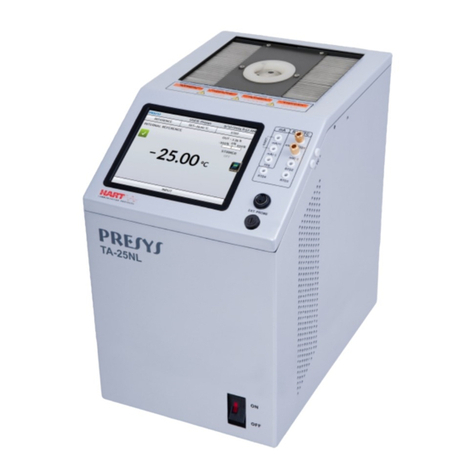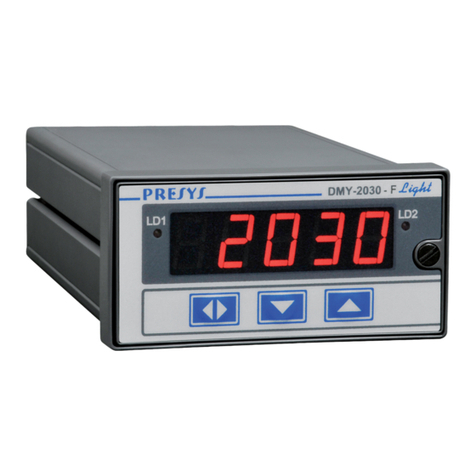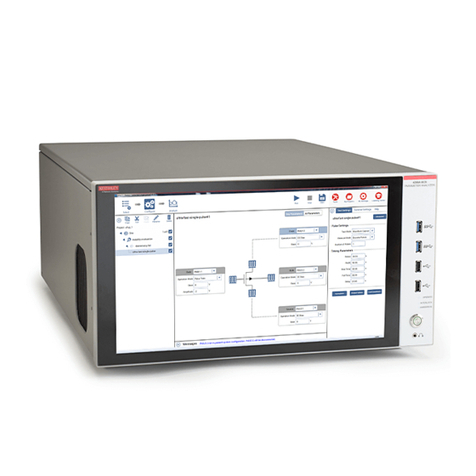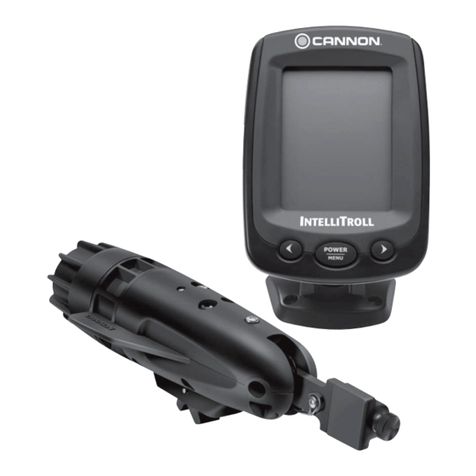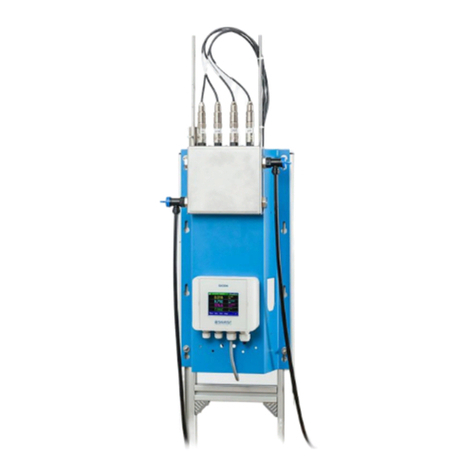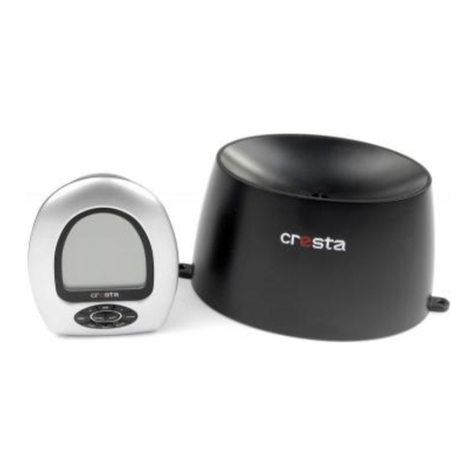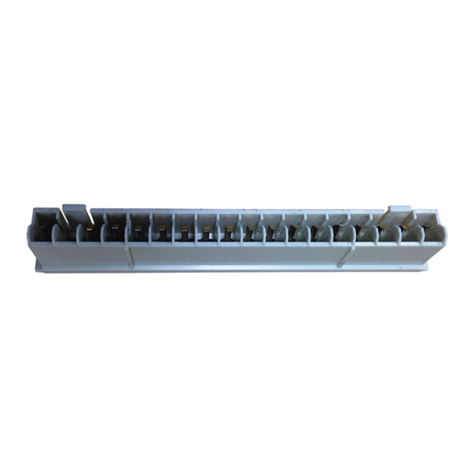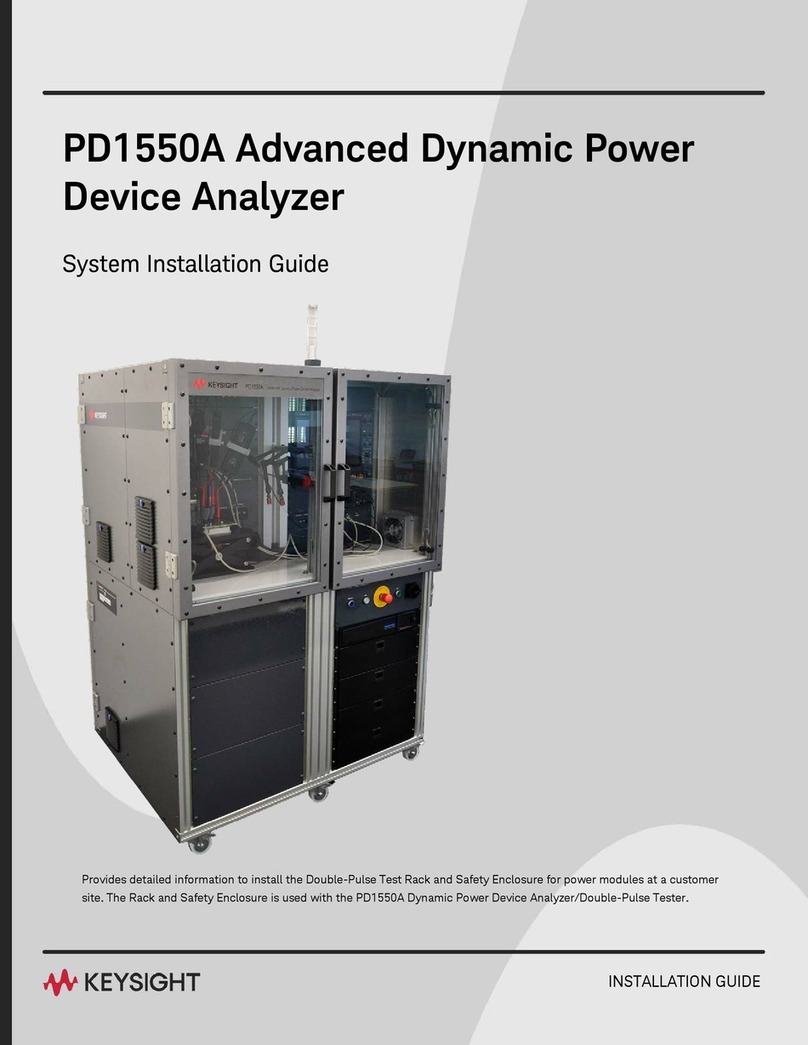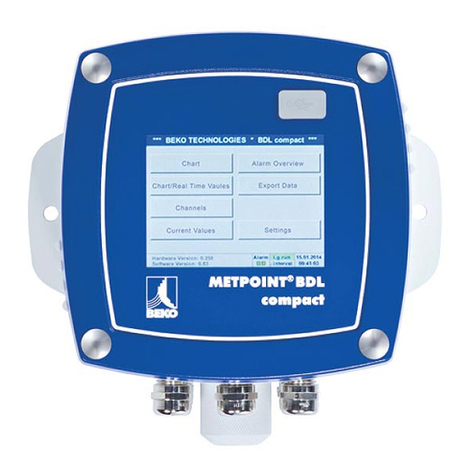Presys DMY-2030 Light User manual

Universal Digital Indicator
DMY-2030 Light
EM0103-02
Technical Manual
R
presys

PRESYS Instruments DMY-2030 Light
EM0103-02
TABLE OF CONTENTS
1.0 - Introduction ............................................................................................................1
1.1 - Description ............................................................................................................ 1
1.2 - Order Code ........................................................................................................... 2
1.3 - Technical Specifications ........................................................................................ 4
2.0 - Installation ..............................................................................................................7
2.1 - Mechanical Installation .......................................................................................... 7
2.2 - Electrical Installation ............................................................................................. 7
2.3 - Process Input Signal Connections ........................................................................ 8
2.3.1 - Thermocouple Input ....................................................................................... 9
2.3.2 - RTD Input ....................................................................................................... 9
2.3.3 - Milliampere Input .......................................................................................... 10
2.3.4 - Volt or Millivolt Input ..................................................................................... 11
2.4 - Output Connection .............................................................................................. 11
2.5 - Connection Diagram ........................................................................................... 13
2.6 - Communication ................................................................................................... 14
2.7 - Engineering units ................................................................................................ 14
3.0 - Operation ..............................................................................................................15
3.1 - Normal operation ................................................................................................ 15
3.2 - Configuration....................................................................................................... 16
presys

PRESYS Instruments DMY-2030 Light
Introduction
Page 1
1.0 - Introduction
1.1 - Description
PRESYS DMY-2030 Light Indicator is able to monitor one universal standard
input and accepts direct connection of thermocouples, RTD, current (mAdc) and voltage
(mVdc, Vdc). Thermocouples and RTD inputs are linearized automatically by tables
stored in EPROM memory. There is a 24Vdc voltage source isolated from output and
with short-circuit protection in order to power transmitters.
It can communicate with computers by means of an optional communication
module RS-232 or RS-422/485.
The type of input is selected by software configuration, together with the
connection of the input signal to the proper terminals. All configuration data is protected
by password and stored in non-volatile memory.
According to modularity design concept, the Indicator accepts up to three output
modules. One can make use of one retransmitter output (4-20mA, 1-5V, 0-10V) and up
to two output alarm modules (SPDT relay, solid state relay or open collector voltage).
The alarm outputs can be configured independently to operate with latch, what requires
the operator acknowledge by means of the front panel keys in order to deactivate the
outputs after the process variable returns to normal condition. The outputs are electrically
isolated from inputs.
PRESYS DMY-2030 Light
Fig. 1 - DMY - 2030 Light Indicator front panel
The front panel has a high visibility display configurable up to 4 ½ digits to show
the process variable. The leds are used as a visual indication of alarm associated to the
alarm outputs. During configuration, the display shows mnemonics and parameter
values.
It accepts 90 to 240Vac or 130 to 340Vdc (with any polarity) power supply.
The instrument has an extruded aluminum case which avoids electrical noise,
electromagnetic interference, radiofrequency interference, etc., and its robust
construction makes it tough enough for the most hostile environment.
presys

PRESYS Instruments DMY-2030 Light
Introduction
Page 2
1.2 - Order Code
DMY - 2030 Light
-
-
-
-
-
-
A
B
C
D
E
F
Field A Output 1
0 Not used
1 4 to 20mA
2 1 to 5V
3 0 to 10V
Field B Output 2
0 Not used
1 SPDT relay
2 Open collector voltage
3 Solid state relay
Field C Output 3
Same code of Output 2
Field D Power Supply
1 90 to 240Vac or 130 to 340Vdc (any polarity)
2 24Vdc
3 12Vdc
Field E Communication
0 Not used
1 RS 232
2 RS 485
Field F Case Protection Grade
0 General usage, protected place
1 Front aspersion-proof
2 Weather-proof
Note 1 - The input type, indication and relay usage as alarms are, among other
things, items that the user can program through the front keys (if wanted, specify these
information so that all the configuration can be made by PRESYS).
Note 2 - Other hardware and software features can be available under previous
consult.
Code Example:
1) DMY - 2030 Light - 0 - 1 - 0 - 1 - 0 - 0
presys

PRESYS Instruments DMY-2030 Light
Introduction
Page 3
This code defines a DMY-2030 indicator with one SPDT relay which can be used
as high and low alarm, 90 to 240Vac or 130 to 340Vdc electric power supply, protected
field usage.
presys

PRESYS Instruments DMY-2030 Light
Introduction
Page 4
1.3 - Technical Specifications
Input:
One input configurable for thermocouple (J, K, T, E, R, S, under ITS -
90), Pt-100 RTD under DIN 43760, 4 to 20mA, 0 to 55mVdc, 1 to 5Vdc,
0 to 10Vdc. 250
input impedance for mA, 10M
for 5Vdc and 2M
above 5Vdc. Table 1 shows the temperature ranges for thermocouples
and RTD, and the resolution for linear input sensors.
Input Sensor
Measuring Range Limits
Thermocouple
lower
limit
F
higher
limit
F
lower
limit
C
higher
limit
C
Type J
-184.0
1886.0
-120.0
1030.0
Type K
-346
2498
-210
1370
Type T
-418
752
-250
400
Type E
-148.0
1436.0
-100.0
780.0
Type R
-58
3200
-50
1760
Type S
-58
3200
-50
1760
RTD
3-wire Pt-100
-346.0
1256.0
-210.0
680.0*
Linear
Span
Resolution
Voltage
0 to 55mV
3V
1 to 5V
250V
0 to 10V
500V
Current
4 to 20mA
1A
(*) includes wire resistance
Table 1 - Measuring ranges for input sensors
presys

PRESYS Instruments DMY-2030 Light
Introduction
Page 5
Outputs:
One 4 to 20mA, 1 to 5Vdc or 0 to 10Vdc analog retransmitter optional
module galvanically isolated up to 300Vac from power supply and input.
SPDT relays for alarm rated for 3A at 220Vac or up to 10A at 220Vac
under order (in this case, the alarm module is not plugged to a connector,
but soldered to the board). It is possible to use up to 2 alarm modules.
Logic signal, open collector transistor, 24Vdc, 40mA max. with isolation.
Solid state relay rated for 2A at 250Vac with isolation.
Serial Communication:
RS-232 or RS-485, with 50Vdc isolation, as an optional module for
connection in the CPU board.
Indication:
Standard indication of -9999 to 19999 range.
Configuration:
By front panel push-buttons and internal jumpers (for the output).
Sampling rate:
64ms sampling rate, for the indication of input in -9999 to 19999 range.
The display is updated each 0.5 second.
Accuracy:
0.1% of full scale for TC, RTD, mA, mV and V input.
0.5% of full scale for analog retransmitter output and 750
maximum
load.
Linearization:
0.1
C for RTD and
0.2
C for TC.
Square root extraction:
0.5% of reading, for input above 10% of span. 0 to 5% programmable
Cut-off.
presys

PRESYS Instruments DMY-2030 Light
Introduction
Page 6
Cold junction compensation:
2.0
C at range from 0 to 50
C ambient temperature.
Thermal stability:
0.005% /
C of span with reference of 25
C ambient temperature.
Power supply:
Universal 90 to 240Vac or 130 to 340Vdc (any polarity), 10W nominal;
24Vdc, 12Vdc and other values are optional.
2-wire transmitter power supply:
24Vdc voltage and 50mA maximum, isolated from output, short-circuit
protection.
Operating Ambient:
0 to 50
C temperature and 90% maximum relative humidity.
Dimensions:
1/8DIN (48 x 96mm) with 162mm depth, panel cut of 45 x 92mm.
Weight:
0.5kg approx.
Warranty:
One-year warranty.
presys

PRESYS Instruments DMY-2030 Light
Installation
Page 7
2.0 - Installation
2.1 - Mechanical Installation
DMY-2030 Light Indicator front panel has 1/8DIN size (48 x 96mm).
It is fixed by the rails which press it against the back side of the panel.
After preparing a 45 x 92mm cut in the panel, remove the rails from the Indicator
and slide its rear through the cut until its front reaches the panel. Place the rails again in
the Indicator from the back of the panel and tighten the screws as shown in figure 2.
Fig. 2 - Dimensional drawing, panel cutout and side view
2.2 - Electrical Installation
DMY-2030 Light Indicator may be powered by voltage between 90 and 240Vac or
130 to 340Vdc, any polarity. Remember that the internal circuit is powered whenever the
instrument is connected to the external power supply.
presys

PRESYS Instruments DMY-2030 Light
Installation
Page 8
Input and output signals must be connected to the instrument only when it is
turned off.
Figure 3 shows the instrument rear terminals for connection of power supply,
ground, communication, process input and output signals.
Signal wiring must be kept far away from power wires.
Due to its metal case the instrument ground should be connected to earth ground.
Never connect the ground to neutral terminal.
Fig. 3 - Indicator terminals
2.3 - Process Input Signal Connections
The Indicator universal standard inputs can be connected to thermocouples, 3-
wire RTD, current (mA) or voltage (V or mV). See the different types and ranges of input
sensors in table 1, section 1.3 on Technical Specifications.
The input sensor is enabled by software configuration (see section 3.2 on
Configuration) and by the selection of the appropriated terminals of the
instrument.
In order to avoid noise in the wiring, use twisted pair cable and cross sensor
connection wire inside a metallic tube or use shielded cable. Make sure to connect only
one shield wire end either to board terminal or to sensor ground, as shown in the next
items.
WARNING: GROUNDING TWO SHIELD WIRE ENDS MAY CAUSE NOISE IN THE
INDICATOR.
presys

PRESYS Instruments DMY-2030 Light
Installation
Page 9
2.3.1 - Thermocouple Input
Connect the thermocouple to terminals 2(+) and 3(-) as shown in figure 4.
In order to reduce the error due to cold junction compensation, use thermal paste
in the rear (from the terminals where the thermocouple is connected to the cold junction
sensor). Use appropriate compensating cables with the same material of the
thermocouple in order to connect it to the instrument. Check if the thermocouple polarity
is equal to those of the terminals.
Fig. 4 - Thermocouple connection
2.3.2 - RTD Input
The 3-wire RTD is connected to terminals 1 and 3, and the compensation wire is
connected to terminal 2.
Use wires of same material, gauge and length on all 3 for compensating
resistance. The maximum resistance of each connection wire must be 10. Use 18AWG
wire (minimum) for distances up to 50m and 16AWG for distances greater than 50m.
Fig. 5 - RTD connection
presys

PRESYS Instruments DMY-2030 Light
Installation
Page 10
2.3.3 - Milliampere Input
The 4-20 mA current signal is applied to terminals 5(+) and 6(-). The current
signal can be generated by a transmitter with an external power supply. In case of using
the 24Vdc internal voltage source from the Indicator to power a two-wire transmitter, the
current is received only by terminal 5(+). Figure 6 shows both possibilities of connection.
Fig. 6 - Milliampere Input
presys

PRESYS Instruments DMY-2030 Light
Installation
Page 11
2.3.4 - Volt or Millivolt Input
0 to 55mVdc or 0 to 5 Vdc must be applied to terminals 2 (+) and 3 (-). 0 to 10Vdc
must be applied to terminals 4(+) and 6(-). The connections are shown in figure 7.
Fig. 7 - Voltage source connection
2.4 - Output Connection
The Indicator can have up to three output modules: output 1 to 3. Output 1 is used
as a retransmitter output (4 to 20mA, 1 to 5Vdc or 0 to 10Vdc). Outputs 2 and 3 are used
only as alarm outputs (SPDT relay, open collector voltage and solid state relay). Figure 8
shows the Indicator output types.
Note that the output terminals will present the corresponding signals only if the
optional modules are installed and the output is correctly configured. Refer to section 3.2
on Configuration for further details.
presys

PRESYS Instruments DMY-2030 Light
Installation
Page 12
(*) Position of relay contacts when the Indicator is powered on and in non-alarm condition.
When the Indicator is powered off or in alarm condition, the position of the relays changes.
Fig. 8 - Output Connection
presys

PRESYS Instruments DMY-2030 Light
Installation
Page 13
2.5 - Connection Diagram
presys

PRESYS Instruments DMY-2030 Light
Installation
Page 14
2.6 - Communication
DMY-2030 Light Indicator communicates with computers through RS-232 or
RS-485 and with use of a MODBUS protocol communication software, when the optional
communication module is installed and the communication parameters are configured.
Specific information on communication and signal connection is described in the
communication manual.
2.7 - Engineering units
A label with several Engineering Units is supplied with each Indicator. Select the
one corresponding to the variable shown on the display and stick it to the front panel of
the Indicator.
presys

Presys Instruments DMY-2030 Light
Operation
Page 15
3.0 - Operation
3.1 - Normal operation
DMY-2030 Light Indicator has two modes of operation: normal operation and
configuration mode.
During normal operation, the Indicator monitors the inputs, verifies alarm
conditions and activates the outputs when necessary.
Configuration mode is used to select and configure all the Indicator parameters.
The normal operation mode, in which the Indicator is to be found most of the time,
is called level zero. In this level, the three front panel keys have the following functions:
Key
ENTER
Changes information shown on the display. When
the display shows the process variable, it goes to
alarm 1 setpoint, if configured. Next, one can see
alarm 2 setpoint (if configured), the “Conf”
mnemonic (which allows one to enter the
configuration level) and the process variable again.
It allows the acknowledgment of alarms configured
with latch function, after the alarm condition
returned to normal state.
Key
DOWN
Decreases the setpoint value of the alarm
shown.
Key
UP
When “Conf“ is shown, the password for changing
from level zero to level one is asked. Increases the
setpoint value of the alarm shown. Presents the
alarms which require acknowledgment, when the
process variable is shown, and allows returning to
the process variable.
The information sequence presented on the display is shown on figure 9.
Fig. 9 - Information in the operation level.
The normal operation and configuration modes present a “timer” which make the
display return to the process variable, when it shows any other kind of information and no
key is pressed for 1 minute. It does not apply to the Calibration level (Calib. mnemonic).
See item 3.2 on Configuration.
presys

PRESYS Instruments DMY-2030 Light
Operation
Page 16
3.2 - Configuration
In order to access the configuration mode the operator is required to provide a
password which avoids a non-authorized person to change any critical parameters of the
process. So, when UP is pressed while “Conf” is shown in the normal operation mode,
the PASS warning is displayed and the user should press the UP, DOWN and ENTER
keys (exactly in this order) to access the configuration levels. If the user provides an
incorrect sequence of keys or if it takes more than 15 seconds for the password to be
given, the display returns immediately to the normal operation level. This procedure is
shown in figure 10.
Note: In the diagrams below, the rectangles represent
the display appearance after pressing the keys.
Fig. 10 - Key sequence password
All configuration parameters are stored in the non-volatile memory and determine
the normal operation of the instrument. With these parameters the user can adjust the
instrument to his needs, when it is necessary to change the configuration from factory.
Configuration parameters are distributed in six hierarchical levels shown in figure
11.
Fig. 11 - Parameter levels diagram
presys

Presys Instruments DMY-2030 Light
Operation
Page 17
In order to move through the levels and access the parameters of any one of
them, use the front panel keys which have the following functions:
Key
Description
ENTER
Enters the level
UP
Moves to higher levels
DOWN
Moves to lower levels
The Indicator allows the user to know what kind of input, alarms or output are
configured without need to access a specific parameter level. The mnemonics
corresponding to the level and to the configuration chosen move on the display
continuously, as soon as one reaches one of the levels (except Calib. and RS).
Inside each level, the front panel keys have the following functions:
Key
Description
UP
Moves the options in increasing direction
DOWN
Moves the options in decreasing direction
ENTER
Confirm or advance options inside a level, if the display does not show ESC.
When ESC is shown, it returns one or more positions.
When accessing any parameter of a configuration level, the Indicator directly
shows the option or value corresponding to the current configuration of the parameter. In
case a value is presented, use the UP and DOWN keys to change each digit and press
ENTER to move to the next one. When configuring the options of a parameter, the UP
and DOWN keys are used to move through the options and the ENTER key, to confirm
the choice.
The hierarchical levels are presented in sequence. The options of each level are
explained step by step with all their corresponding parameters.
presys

PRESYS Instruments DMY-2030 Light
Operation
Page 18
Level 1 - Input
The input sensors, described in table 1 of section 1.3 on Technical Specifications,
are configured according to the parameters of the Input level shown below:
Fig. 12 - INPUT level options
presys
Other manuals for DMY-2030 Light
2
Table of contents
Other Presys Measuring Instrument manuals

Presys
Presys DMY-2030-TOT Light User manual

Presys
Presys DMY-2030-CC User manual
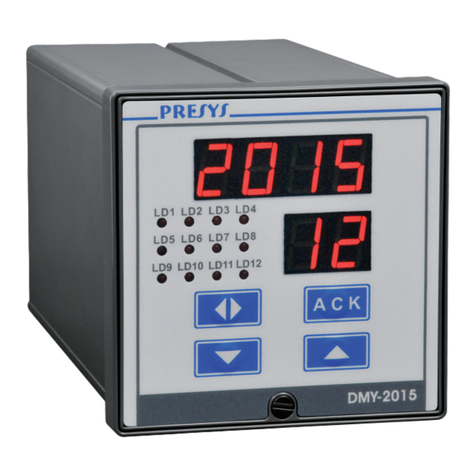
Presys
Presys DMY-2015 User manual
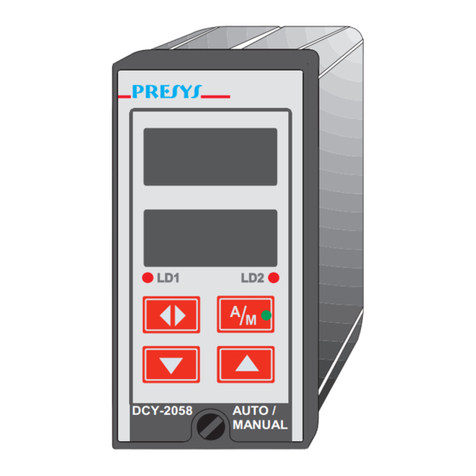
Presys
Presys DCY-2058 User manual

Presys
Presys TE-25N User manual
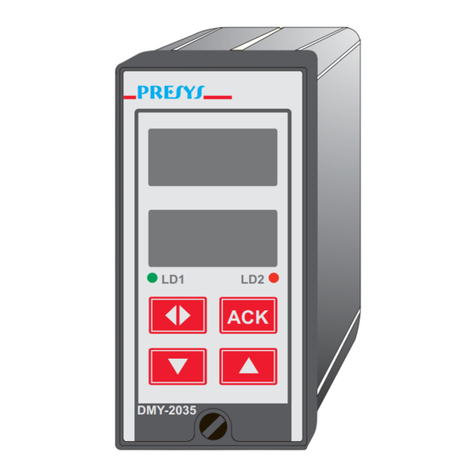
Presys
Presys DMY-2011 User manual

Presys
Presys PROFI BUS DMY-2015-PB User manual
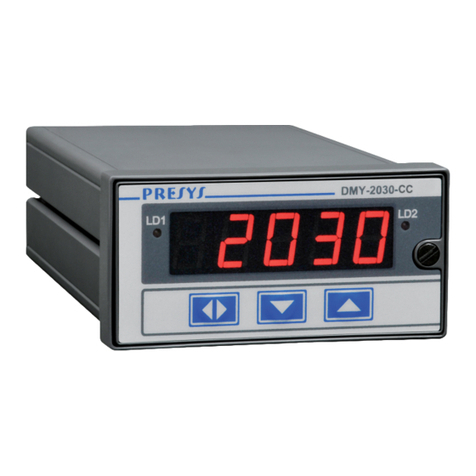
Presys
Presys DMY-2030 Light User manual

Presys
Presys DMY-2030 Light User manual

Presys
Presys TA-60NL User manual
